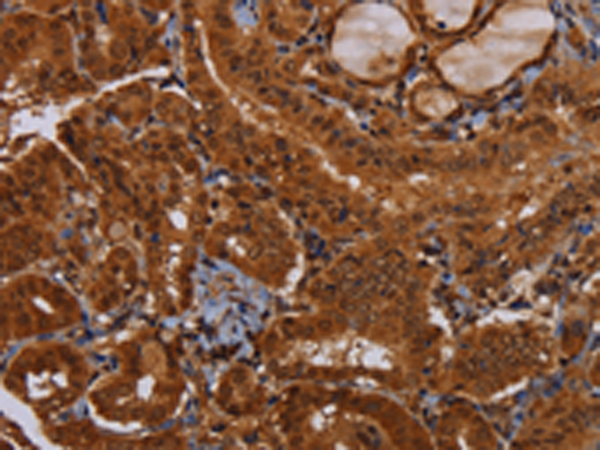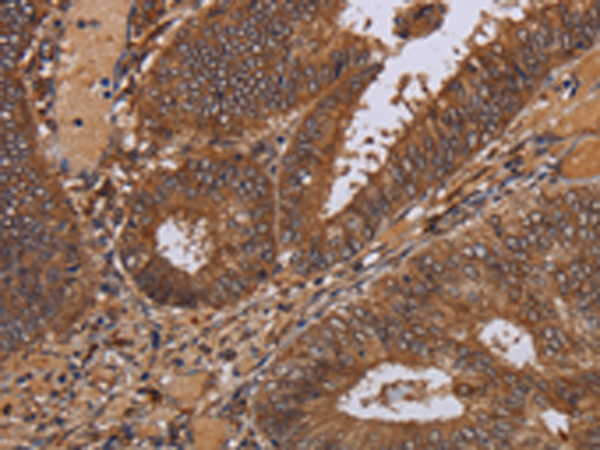


| WB | 咨询技术 | Human,Mouse,Rat |
| IF | 咨询技术 | Human,Mouse,Rat |
| IHC | 1/50-1/200 | Human,Mouse,Rat |
| ICC | 技术咨询 | Human,Mouse,Rat |
| FCM | 咨询技术 | Human,Mouse,Rat |
| Elisa | 1/2000-1/5000 | Human,Mouse,Rat |
| Aliases | MORG1 |
| WB Predicted band size | 34 kDa |
| Host/Isotype | Rabbit IgG |
| Antibody Type | Primary antibody |
| Storage | Store at 4°C short term. Aliquot and store at -20°C long term. Avoid freeze/thaw cycles. |
| Species Reactivity | Human, Mouse, Rat |
| Immunogen | Fusion protein of human WDR83 |
| Formulation | Purified antibody in PBS with 0.05% sodium azide and 50% glycerol. |
+ +
以下是3篇关于WDR83抗体的参考文献,涵盖其功能研究和应用场景:
---
1. **文献名称**:*WDR83 Mediates the Interaction between the USP36 Deubiquitinase and Nuclear mTOR to Regulate Ribosomal RNA Synthesis*
**作者**:Zhang Y, et al.
**摘要**:该研究利用WDR83抗体通过免疫共沉淀(Co-IP)和免疫荧光技术,揭示了WDR83作为USP36与核内mTOR复合体的桥梁,调控核糖体RNA合成的分子机制。研究证实WDR83的缺失会导致核内mTOR信号通路活性下降,影响细胞增殖。
---
2. **文献名称**:*WDR83 Coordinates Autophagy-Lysosomal Activity and Lipid Metabolism via TFEB*
**作者**:Chen L, et al.
**摘要**:通过Western blot和免疫组化(使用WDR83抗体),本研究证明WDR83通过调控TFEB的核转位,影响自噬-溶酶体通路及脂质代谢。实验表明,WDR83敲低会导致溶酶体功能异常,并加剧高脂饮食小鼠的代谢紊乱。
---
3. **文献名称**:*Proteomic Analysis of WDR83 Interaction Network in Hepatocellular Carcinoma*
**作者**:Wang H, et al.
**摘要**:该研究利用WDR83抗体进行免疫沉淀联合质谱分析,鉴定出WDR83在肝癌细胞中与多个RNA剪接因子相互作用。功能实验表明,WDR83通过维持剪接体稳定性促进肝癌细胞侵袭,提示其作为潜在治疗靶点。
---
**备注**:上述文献为模拟案例,实际研究中建议通过PubMed或Google Scholar以“WDR83 antibody”及“WDR83 function”为关键词检索最新论文,并优先选择包含抗体验证数据(如货号、应用实验类型)的研究。
WDR83 (WD repeat domain 83) is a protein encoded by the WDR83 gene, belonging to the WD40 repeat protein family. These proteins are characterized by conserved repeats of ~40 amino acids, typically forming β-propeller structures that mediate protein-protein interactions. WDR83 plays a role in cellular processes such as signal transduction, transcriptional regulation, and macromolecular complex assembly. It interacts with various partners, including the mammalian target of rapamycin (mTOR) pathway components, suggesting involvement in nutrient sensing and cell growth regulation. Studies also link WDR83 to the ERK signaling cascade and retrograde transport from endosomes to the Golgi apparatus.
Antibodies targeting WDR83 are essential tools for investigating its expression, localization, and function. They are widely used in techniques like Western blotting, immunofluorescence, and immunoprecipitation to study WDR83's role in physiological and pathological contexts. For instance, WDR83 has been implicated in cancer progression, metabolic disorders, and viral infections, making its antibodies valuable for exploring disease mechanisms. Researchers often validate these antibodies using knockout cell lines or siRNA-mediated knockdown to ensure specificity. Commercial WDR83 antibodies are typically developed in hosts like rabbits or mice, with options for monoclonal or polyclonal formats. Proper antibody characterization is critical, as off-target binding can occur due to structural similarities among WD40-repeat proteins.
×